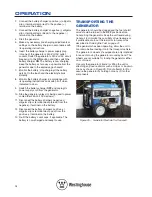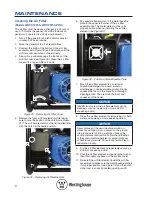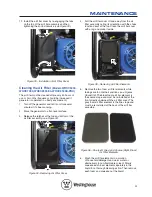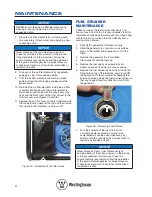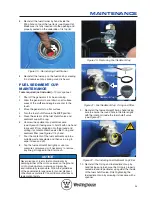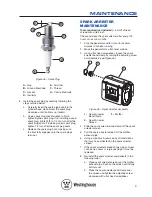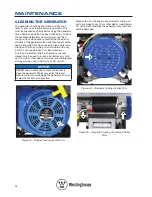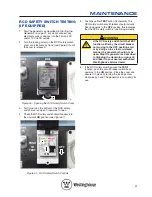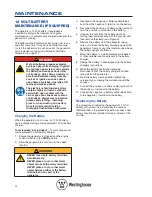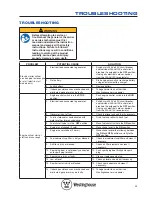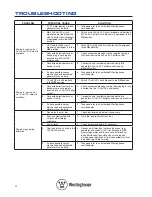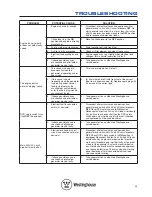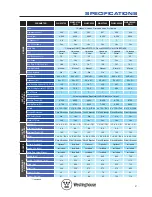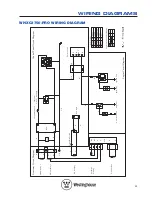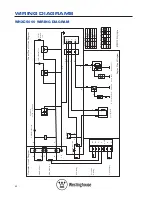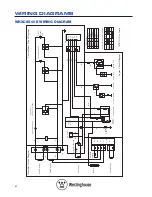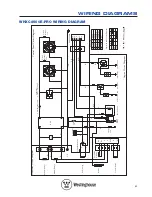
42
MAINTENANCE
Proper care should be taken to prepare the generator
for any long-term storage. This will protect the
generator’s function and appearance, and will make it
easier to start when required on the next occasion.
Storage Procedure for 1 – 3 Months
1. Clean the generator as outlined in Cleaning the
Generator on page 38.
2. Add a proprietary fuel stabilizer to the fuel tank
and then add fresh fuel up to the tank’s maximum
capacity (see checking and Adding Fuel on page
20). Follow the manufacturer’s recommendation for
correct amount of stabilizer to add.
3. Start the generator and then run it for 10 minutes
to ensure that treated fuel is distributed throughout
the engine’s fuel system. Then stop the generator
and turn the fuel shutoff valve to the OFF position.
4. Allow the unit to cool down and then move it to a
clean, dry place for storage.
5. For electric-start models equipped with a 12 Volt
battery, the battery should be re-charged at
intervals of no more than 3 months (see Charging
the Battery on page 40).
Storage Procedure for Greater than
3 Months
1. Clean the generator as outlined in Cleaning the
Generator on page 38.
2. Drain the fuel (see Draining the Fuel on page 41).
3. Change the engine oil (see Changing Engine oil
on page 31).
4. Remove the spark plug (see spark Plug
Maintenance on page 36) and pour a tablespoon
of clean engine oil into the spark plug opening.
While placing a clean rag over the spark plug
opening, slowly pull the recoil starter handle to
rotate the engine several times. This will distribute
the oil and protect the cylinder wall from corrosion
during storage.
5. Re-install the spark plug (see spark Plug
Maintenance on page 36).
6. Move the generator to a clean, dry place for
storage.
7. For electric-start models equipped with a 12 Volt
battery, the battery should be re-charged at
intervals of no more than 3 months (see Charging
the Battery on page 40).
Removal from Storage
Follow the normal procedures for pre-operation checks
and starting
(see Before Starting the Generator on
page 19).
Use only fresh fuel to re-fill the tank, if necessary,
rather than re-using the old fuel.
If oil was inserted into the cylinder prior to storage, the
exhaust may smoke for a short while after starting the
generator; this is normal and will cease within a minute
or so of running time.
DisMantling anD DisPosal
There is no requirement for the generator to be
dismantled during normal operation other than for
major repair/overhaul or prior to final disposal at the
end of its service life.
Dismantling should only be carried out by a
mechanically proficient person with access to proper
tools or alternatively by your authorized Westinghouse
service dealer for a fee.
Before dismantling:
1. Stop the generator (see Stopping the Generator
on page 24).
2. Drain the engine oil (see Changing Engine Oil on
page 31).
3. Drain the fuel (see Draining the Fuel on page 41).
4. Disconnect and remove the battery, if equipped
(see 12 Volt Battery Maintenance on page 40).
NOTICE
Do not pollute the environment by improper or
illegal disposal of the waste fluids or 12 Volt battery.
Dispose of these hazardous items only at an
authorized waste collection/recycling facility.
Do not pollute the environment by improper or illegal
disposal of the generator either as a whole or in
parts. Take the unwanted unit or components to
your local recycling centre instead. The generator is
made almost entirely of metal that can be recycled.
Summary of Contents for WHXC3750
Page 4: ...4...
Page 55: ...55 NOTES...

